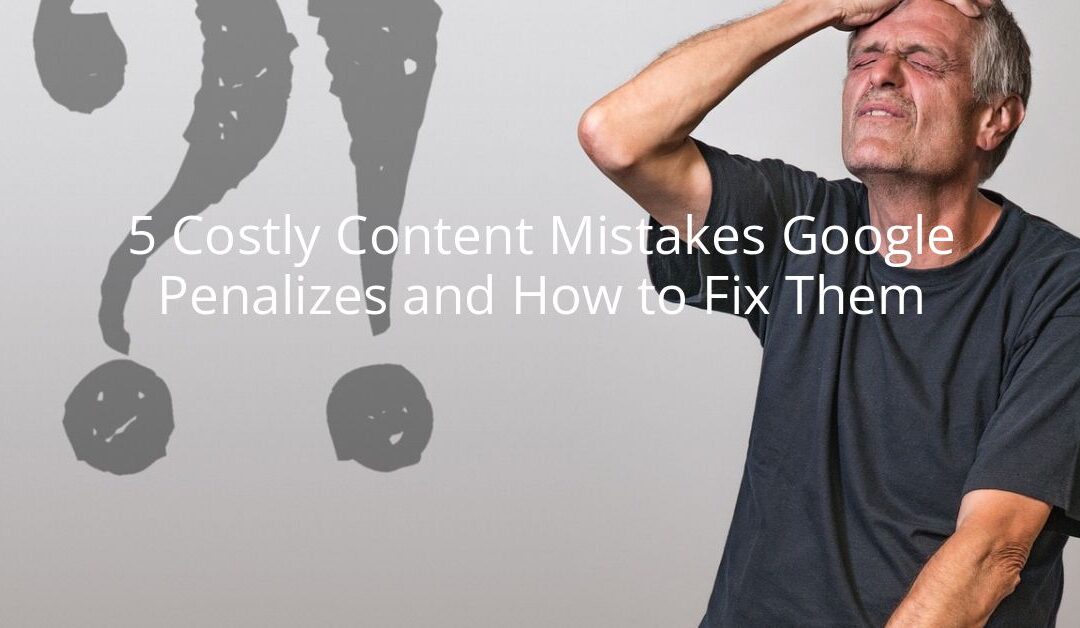Imagine this: after pouring hours of effort into crafting the perfect article, you hit “publish” and wait eagerly for the surge of visitors. Days pass, then weeks, but your site’s traffic resembles a deserted street more than the bustling hub you’d envisioned. Could it be that hidden within your content are subtle missteps that are costing you Google’s approval—and rankings?
In the digital landscape, where Google’s algorithms silently assess every word and image, certain content mistakes can spell trouble. These errors are like invisible tripwires: easy to overlook, but when triggered, they keep your content from achieving its potential. To help your website avoid these costly pitfalls, here are five common content mistakes that Google penalizes—and how you can fix them to keep your content ranking high and your audience engaged.
Related: Going Beyond: Strategies to Amplify Your Content and Engage a Wider Audience
1. Keyword Stuffing: When Good Intentions Go Overboard
Imagine having a conversation where every other word is “best SEO content.” Awkward, right? That’s essentially what keyword stuffing feels like to Google’s crawlers. Once upon a time, saturating content with keywords might have nudged your site up the rankings. But now, it’s like a neon sign that screams “spam.” Google frowns upon keyword stuffing because it disrupts readability and diminishes user experience.
How to Fix It: Think of keywords as delicate spices. A pinch adds flavor, but too much ruins the dish. Use your keywords naturally, letting them blend seamlessly with the flow of your writing. Embrace related phrases and variations that keep your content relevant without feeling forced. ContentERP’s built-in keyword tool is like a culinary guide, helping you measure just the right amount of keywords to keep Google and readers satisfied.
2. Thin Content: All Sizzle, No Steak
Thin content is the online equivalent of a picture-perfect dish that leaves you hungry. Pages that lack substance, depth, or practical insight disappoint users and send negative signals to Google. A superficial, underdeveloped article signals to the algorithm that your site doesn’t offer real value, pushing it lower in search rankings.
How to Fix It: Build your content to satisfy your audience’s hunger for knowledge. Dive into your topic, offer real takeaways, and leave readers with something actionable. Instead of scratching the surface, delve deep and showcase your expertise. At ContentERP, tools like content analysis and readability checks can guide you in creating articles that are rich, fulfilling, and highly readable.
3. Poor Mobile Optimization: Ignoring the Small Screen
In today’s mobile-first world, a clunky, unresponsive website is like a coffee shop with no seating: inconvenient, frustrating, and destined to lose customers. Over 60% of all web searches happen on mobile devices, and Google has prioritized mobile-friendly sites in its ranking algorithm. Neglecting mobile optimization is a fast-track way to Google’s bad side.
How to Fix It: Make sure your site and content are mobile-friendly. Use a responsive design, break up paragraphs, and add images that scale well on smaller screens. Readers should be able to scroll easily, read clearly, and engage without pinching and zooming.
4. Outdated Information: Letting Your Content Age Without Grace
 Image by bess.hamiti@gmail.com from Pixabay
Image by bess.hamiti@gmail.com from Pixabay
Search engines love fresh, relevant content—and penalize sites that allow outdated information to sit unattended. When facts and statistics fade with time, Google notices. If you let your content stagnate, Google may mark it as less relevant, pushing it further down the search results.
How to Fix It: Regularly audit your content to ensure it’s fresh and accurate. Update statistics, include recent insights, and refresh your links. Adding new sections or reformatting to reflect current trends can give old articles new life. With ContentERP, you can track and refresh posts, keeping them relevant and worthy of Google’s—and your readers’—attention.
5. Skipping Meta Descriptions: Wasting a Golden Opportunity
 Image by Sasin Tipchai from Pixabay
Image by Sasin Tipchai from Pixabay
The meta description may be small, but it packs a punch. This 150-character summary can be the deciding factor between a searcher clicking your link or moving on to another. Think of it as a movie trailer: it teases the content and draws readers in. Yet many content creators skip it, assuming Google will handle it. Google’s AI is capable, but an auto-generated description often misses the mark, costing you precious clicks.
How to Fix It: Always create a concise, engaging meta description. Include your primary keyword, offer a compelling snapshot, and leave readers curious enough to click. ContentERP’s real-time SEO editor lets you draft and optimize these snippets, providing previews to ensure your meta descriptions catch the eye and match Google’s standards.
A Fresh Start for Content Success
 Image by Ryan McGuire from Pixabay
Image by Ryan McGuire from Pixabay
Picture your website as a cozy bookstore, each page a unique chapter inviting readers in to stay awhile. Now imagine that space scattered with dim lights, missing pages, and cluttered aisles—what would keep visitors engaged? By fixing these five common content mistakes, you’re tidying up, bringing clarity, and inviting Google’s algorithm to take notice. Each improvement, whether it’s fine-tuning your keywords or adding a mobile-friendly layout, is like another layer of polish, guiding visitors to your content and keeping them hooked.
If you’re ready to unlock the full potential of your content, ContentERP offers all the tools you need. From keyword balancing to mobile previews and meta description crafting, ContentERP helps you elevate every post. Imagine your content ranking higher, engaging readers longer, and generating the results you’ve always wanted. It’s time to take your content to new heights—sign up with ContentERP and see the difference expertise and innovation can make.
Related: Beyond Basics: Innovative Approaches to Discover SEO Keyword Opportunities


 Image by
Image by  Image by
Image by  Image by
Image by  Image by
Image by